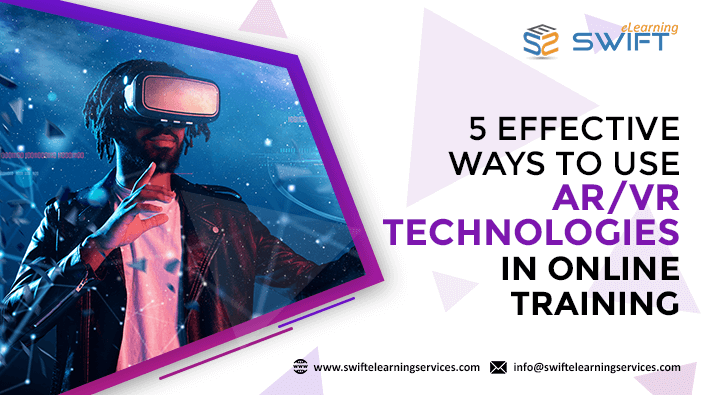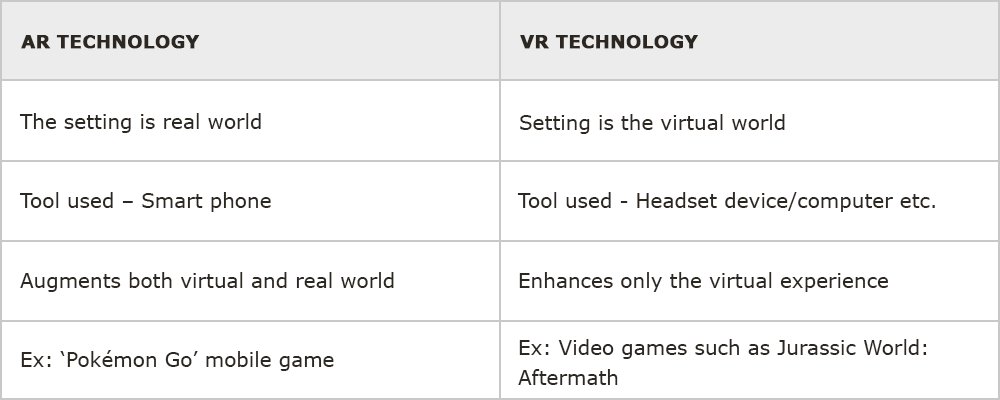5 Effective Ways To Use Augmented Reality (AR) & Virtual Reality (VR) Technologies In Online Training
Have you ever played virtual Cricket? Or have you ever played the ‘Pokémon Go’ game?
If you have already experienced the digital wonder enhanced by AR/VR technologies, you will cherish it for a long time. If you haven’t experienced yet, you must try it once.
Virtual reality (VR) and augmented reality (AR) technologies have changed the way we perceive the digital world, opening doors for new – hitherto unseen – realms of imagination. Today, both these technologies stand as most sought after, with their popularity increasing day by day.
AR and VR – What is the difference, really?
Though they are mentioned together most of the times, there is some significant difference between them.
For example, you can get augmented reality experience with your smart phone. Augmented reality can change your normal, dull physical world into an enhanced experience by projecting virtual images and characters though the smart phone’s camera or video viewer. As the name indicates, this technology augments the user’s real life experience.
On the other hand, virtual reality can produce an entirely different world with computer-generated virtual simulations. These engaging simulations create visuals of an alternative world around, which can be perceived by the user with a special equipment such as headsets, sensors, computers, and gloves.
No doubt, AR/VR technologies are already doing a great job in multiple domains such as automotive, healthcare, manufacturing, space exploration, marketing, real estate and retail.
But, how relevant are they in online training?
An eLearning developer always looks at the technological advancements with a perspective to implement them in online training programs. Though it is true that the usage of AR/VR technologies in online training is not on par with other segments and is nascent in its development, experts feel that within a short time, online training will best utilize them.
In this blog, we will examine 5 effective ways how we can best incorporate the exciting potential of AR/VR technologies in online training.
#1. Provide ‘virtual’ training – to ensure safety to employees
Imagine a big manufacturing company, where the employees need to get trained using huge machinery and tools. There is a probability that they may get hurt while handling the machinery.
AR/VR technologies can come to rescue with the option of virtual training. In this way, the trainees need not handle the physical machinery, but can have ‘almost’ similar experience through virtual simulations. They can feel the virtual environment and handle the virtual objects.
This concept is applied to training programs related to ‘emergency’ as well. What learners cannot touch and experience physically can be best explained using these technologies.
Employees need not schedule access to the machinery, but can go through the online training program using their desktop, laptop or even smart phones. With widespread usage of mobile learning, organizations can successfully train their employees in a bulk, all at the same time.
#2. Make explanation ‘virtual’ – causing it to be more effective!
When new technologies are getting implemented in any domain, their applications open up multi-fold, allowing us to use the technologies thoroughly and effectively.
With proper implementation of AR/VR technologies, online learning can in fact enter the next level. Instead of reading the bulky text on the screen, the learners can touch and experience the virtual ‘objects of learning’ while listening to the narrative audio.
Imagine that in a healthcare training module, when the trainee touches and experiences the ‘virtual’ heart inside the body, their understanding of its functionality will be much effective. Similarly, you can explain a tool more effectively by using these technologies. What was explained previously with images or even videos can now be presented virtually, giving the users a better learning experience.
Complex topics such as anatomical concepts, molecular structures, and space phenomena can be best explained using AR/VR technologies. They can certainly enhance the learning experience as well as the ability to retain.
#3. Make it ‘virtually’ engaging – by providing interactive content
Even in online training, learner interactivity is, by far, limited to clicking a tab or a link, and playing a game inside the module. But, using AR/VR technologies effectively in the training can redefine the terms ‘engaging’ and ‘interactivity’, with learners getting glued to the training modules.
As the simulations of learning objects go beyond the learner’s expectations, the learners will be thrilled with the content presentation and consequently can be greatly benefited with the training program.
#4. Make the gaming experience more ‘virtual’
People of all ages love to play online games. eLearning gamification in online training is no longer new with millions of learners using gamified eLearning courses. But, with AR/VR technologies, the learning experience will undoubtedly multi-fold. To be precise, the gaming scenario will be totally reshaped.
If AR/VR technologies are implemented effectively, the visual and sound experiences will totally be enhanced. Moreover, the learners can touch and feel the gaming elements such as the badges and rewards.
#5. Enhance the quality of scenarios
Just as learners enjoy gamification, they also prefer to understand concepts through scenarios. A well-developed scenario helps the learner grasp the knowledge intended to impart.
Instead of mere images, text and animation effects, when AR/VR technologies are used to build a scenario or a case study, it augments the learning experience in a far better way.
Conclusion
AR/VR technologies are – no doubt – going to rule the digital world. They are going to impact different domains in a wide scale. Online training would also pick the technologies fast in enhancing the learning experience of users.
Our E-learning Services
Translation and Localization Services are tailored to translate eLearning content from one language to another and adapt it to suit the cultural and linguistic preferences of diverse audiences. We translate text, graphics, and multimedia elements to ensure that the content resonates effectively with the target audience. Read More
Custom Content Development involves the creation of bespoke eLearning content tailored to meet the specific training objectives and needs of an organization. We specialize in designing and developing interactive learning materials, such as elearning courses, multimedia presentations, simulations, scenarios, assessments, and games, that align with the organization’s branding, learning goals, and target audience. Read More
Related FAQ
#1. What is the difference between PC VR and standalone VR?
As the name indicates, standalone VR is a virtual reality headset which works completely by itself whereas, in PC VR, the VR headset is constantly connected to a PC.
#2. What are Augmented reality glasses?
Augmented Reality glasses are also known as ‘smart glasses’. AR glasses bring content directly to the eyes so that you don’t need to look at the device screen. This way, AR glasses are just another kind of device through which the AR content is viewed.
Swift eLearning Services has been a front runner in the eLearning industry, offering cost-effective and quality-oriented custom eLearning services, for more than a decade. Along other eLearning services, we will develop virtual simulations in the training programs, to cater for your employee needs. For more details, call us for a demo.





Leave a Reply
Want to join the discussion?Feel free to contribute!